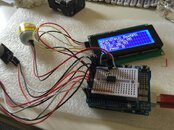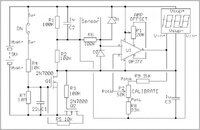Just amplifying the O2 cell's level is not the _right_ way to read it. It works somewhat, and a lot of the el Cheapo analyzers use that method, but it's not the correct loading for the cell to work as spec'd. There's a more elegant way to do it, and it ensures your reading is a lot more accurate.
To get it right, you really want to stabilize the cell with a constant load of 100K across it regardless of calibration. Attached is a standalone schematic of an analog oxygen analyzer (not mine, source now lost, but I built a similar circuit...) It demonstrates the proper way to set up the circuit. If you ignore the on/off circuitry on the left side -- this meter turns on with a SPST pushbutton and automatically turns off whenever the voltage across the R/C network pulls the FETs low -- the rest of the schematic illustrates the proper construction for providing the right load to the O2 cell.
Diodes D1 & D2 protect and ensure that the input of the op amp can never exceed the supply rails by more than the diode's drop voltage - about .6V.
C2 & C3 are for decoupling the supplies to minimize electrical noise etc. Especially using a microcontroller, you need these.
The amplifier output voltage will always drive to a voltage level that results in the voltages at pins 2 and 3 being equal. The voltage at pin 2 is attenuated by the network R8, R9 and P2 and it is the combinations of these that determine the gain of the amplifier.
The lowest gain is given by: (R8+R9+P)/(R8+P), whilst the highest gain is: (R8+R9+P)/R8.
To optimize, the starting point for values of resistors will always be the value of potentiometer P2, as the available values are limited, typically 10K, 20K 50K or 100K. You'll then need to establish the maximum and minimum gains, AH & AL; i.e. AH = 20.9/Vmin and AL = 20.9/Vmax where Vmin & Vmax are the limits of the sensor output quoted on the datasheet. Usually for an R-17 type cell, this is 7 and 17 mV, respectively.
You can now insert these figures into the formulas below:
R8=(AL*P2)/(AH-AL)
R9=(P2+R8)*(AL-1)
Doing it this way gives you a straight reading on the voltmeter, so no math required in software. If you are using an A-D converter in the chip to do your reading, you'd scale the amplifier for 100% O2 on a fresh cell giving you a full-scale reading of your reference voltage instead of targeting 1V full-scale to get the best resolution.





